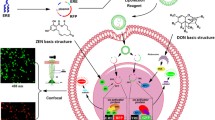Abstract
The recombinant bacteria strain DPD2540, containing afabA::luxCDABE fusion, was used to detect the toxicity of various chemicals in this study. Membrane damaging agents such as phenol, ethanol, and cerulenin induced a rapid bioluminescent response from this strain. Other toxic agents, such as DNA-damaging or oxidative-damaging chemicals, showed a delayed bioluminescent response in which the maximum peak appeared over 150min after induction. This strain was also tested for measurement of toxicity in field samples such as wastewater and river water effluents.
Similar content being viewed by others
References
Bulich, A. A. (1952) A practical and reliable method for monitoring the toxicity of aquatic samples.Process Biochem. 17: 45–47.
Meighen, E. A. (1991) Molecular biology of bacterial bioluminescence.Microbiol. Rev. 55: 123–142.
Hill, P. J., C. E. D. Rees, M. K. Winson, and G. S. A. B. Stewart (1993) The application oflux genes.Biotechnol. Appl. Biochem. 17: 3–14.
Stewart, G. S. A. B. and P. Williams (1992)lux genes and the application of bacterial bioluminescence.J. Gen. Microbiol. 138: 1289–1300.
Gu, M. B., P. S. Dhurjati, T. Van Dyk, and R. A. LaRossa (1996) A Miniature Bioreactor for sensing toxicity using recombinant bioluminescentEscherichia coli.Biotechnol. Prog. 12: 393–397.
Sameer, R., M. B. Gu, K., Konstantinov, P. Dhurjati, T. K. van Dyk, and R. A. LaRossa (1996) Characterization of the stress response of a bioluminescent biosensor in batch and continuous cultures.Biotechnol. Prog. 12: 387–392.
Van Dyk, T. K., W. R. Majarian, K. B. Konstantinov, R. M. Young, P. S. Dhurjati, and R. A. LaRossa (1994) Rapid and sensitive pollutant detection by induction of heat shock genebioluminescence gene fusions.Appl. Environ. Microbiol. 60: 1414–1420.
Gu, M. B., G. C. Gil, and J. H. Kim (1999) A two-stage minibioreactor system for continuous toxicity monitoring.Biosensors Bioelectronics In press.
Belkin, S., D. R. Smulski, S. Dadon, A. C. Vollmer, T. K. van Dyk, and R. A. LaRossa (1997) A panel of stress-responsive luminous bacteria for toxicity detection.Water Research 31: 3009–3016.
Belkin, S. (1998) Stress-responsive luminous bacteria for toxicity and genotoxicity monitoring. p. 171–183. In: P. G. Wells, K. Lee, and C. Blaise (eds.)Microscale Aquatic Toxicology-Advances, Techniques and Practice. CRC Press Boca Raton, FL.
Henry, M. F. and J. E. Cronan (1992) A new mechanism of transcriptional regulation: release of an activator triggered by small molecular binding.Cell 70: 671–379.
Cronan J. E. Jr. and O. R. Charles (1996) Biosynthesis of membrane lipids. p. 612–635. In: F. C. Neidhardt (ed.)Escherichia coli and Salmonella Cellular and Molecular Biology. Vol. 1. 2nd ed. ASM Press Washington D. C.
Sikkema, J. J., A. M. Bont, and B. Poolman (1995) Mechanisms of membrane toxicity of hydrocarbons.Microbiol. Rev. 59: 201–222.
Siegele, D. A. and R. Kolter (1992) Life after log.J. Bacteriol. 174: 345–348.
Nakamura, S., Y. Oda, T. Shimida, I. Oki, and K. Sugimoto (1987) SOS-inducing activity of chemical carcinogens and mutagens inSalmonella typhimurium TA1535/pSK1002: examination with 151 chemicals.Mut. Res. 192: 239–246.
Bruce, D. (1997) Regulation of bacterial oxidative stress genes.Ann. Rev. Genet. 25: 315–337.
Budavary, S. (1989)The Merck Index. An Encyclopedia of Chemicals, Drugs, and Biologicals. 11th ed. Merck & Co. Inc. Rahway, NJ.
Author information
Authors and Affiliations
Corresponding author
Rights and permissions
About this article
Cite this article
Choi, S.H., Gu, M.B. A whole cell bioluminescent biosensor for the detection of membrane-damaging toxicity. Biotechnol. Bioprocess Eng. 4, 59–62 (1999). https://doi.org/10.1007/BF02931916
Issue Date:
DOI: https://doi.org/10.1007/BF02931916




